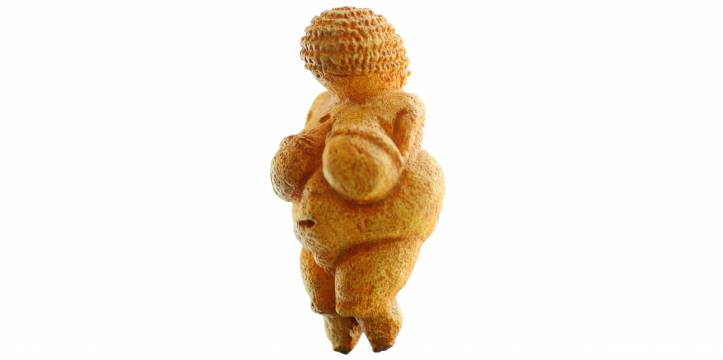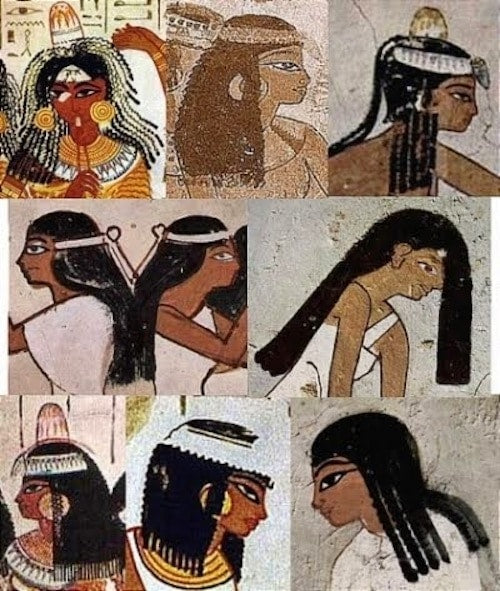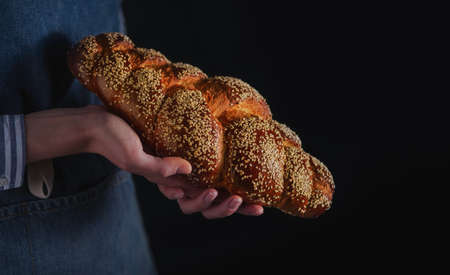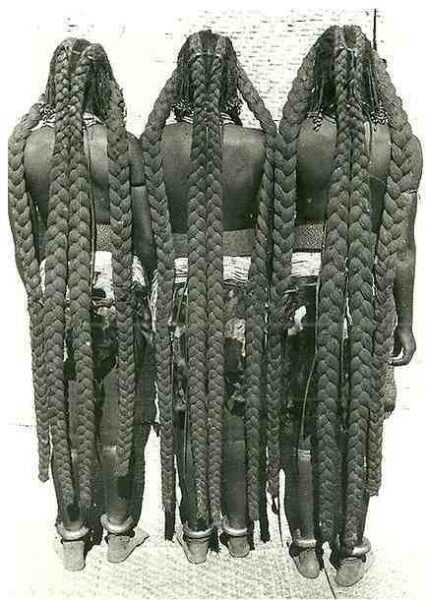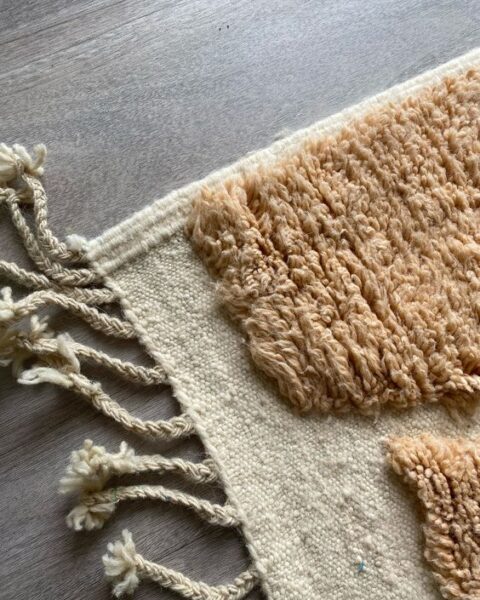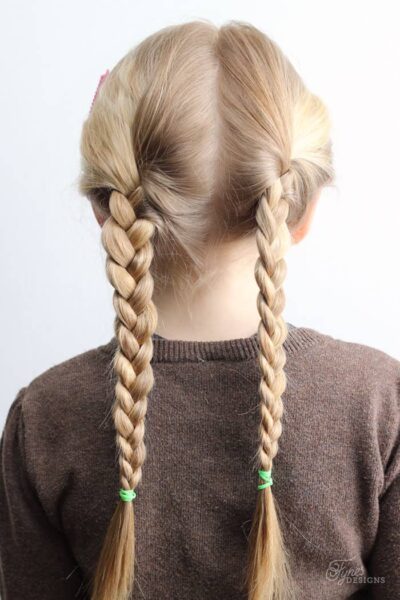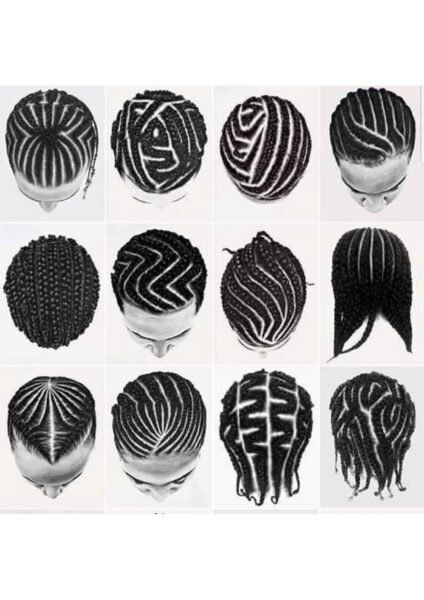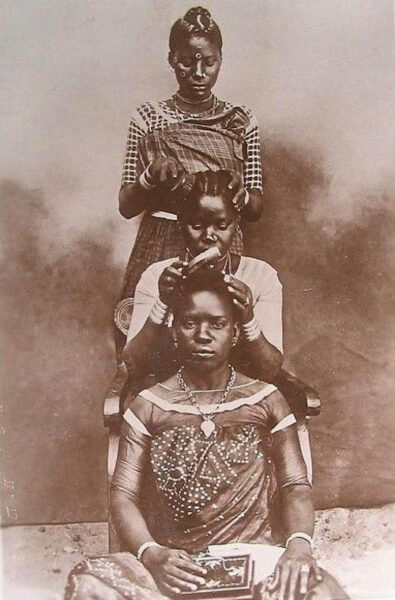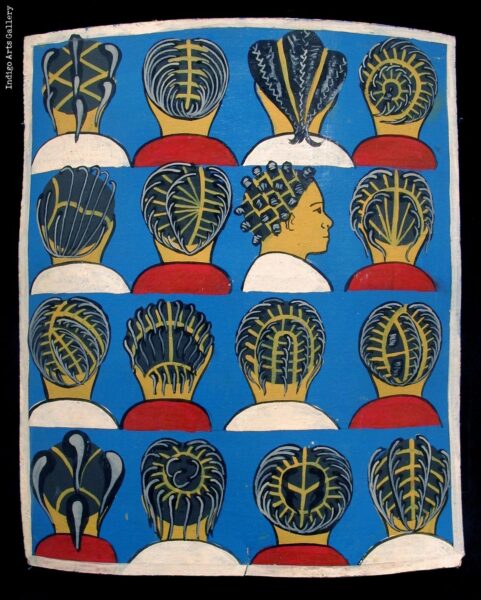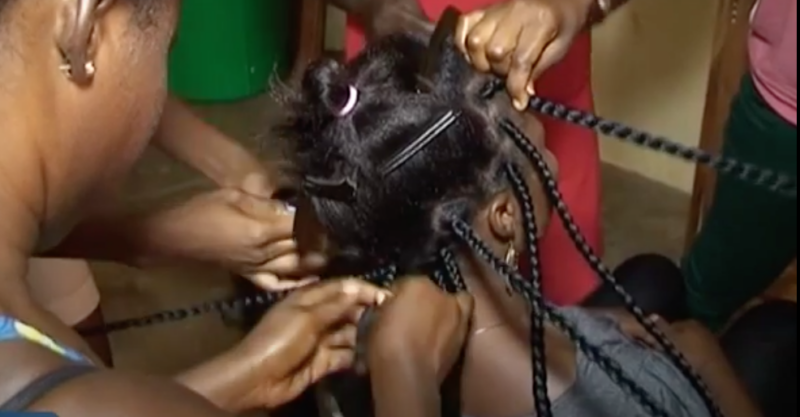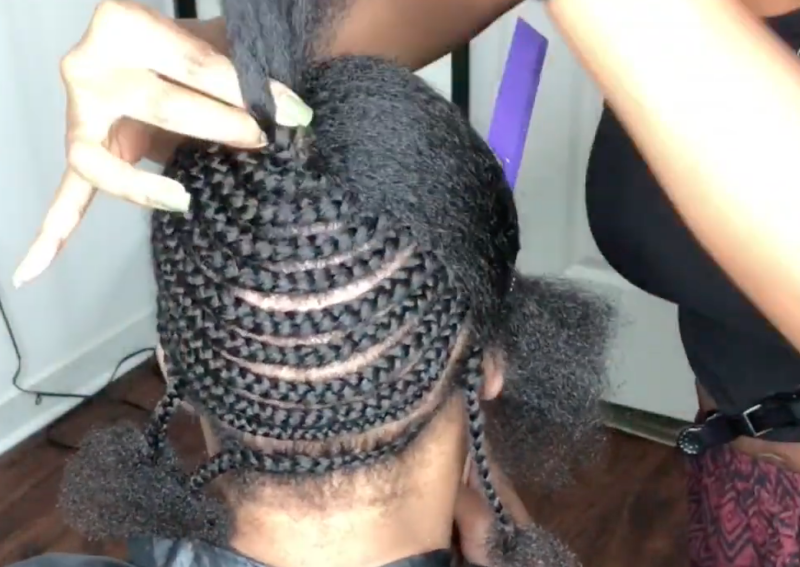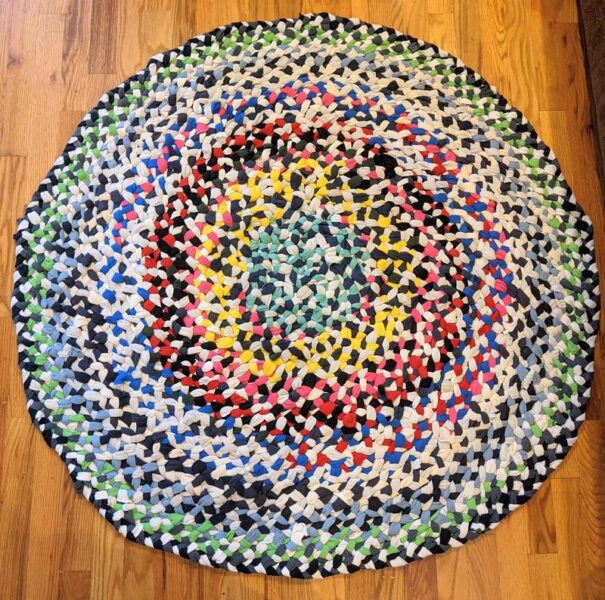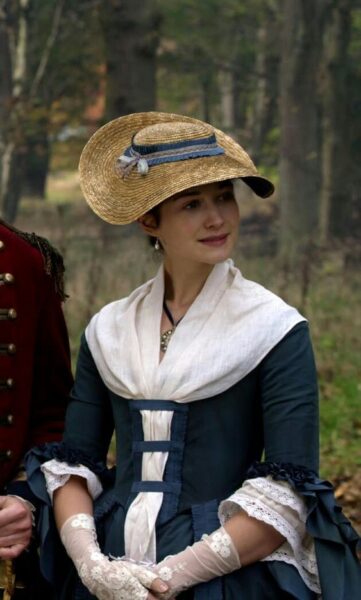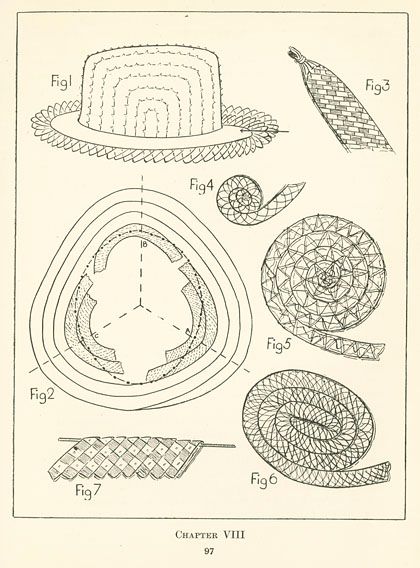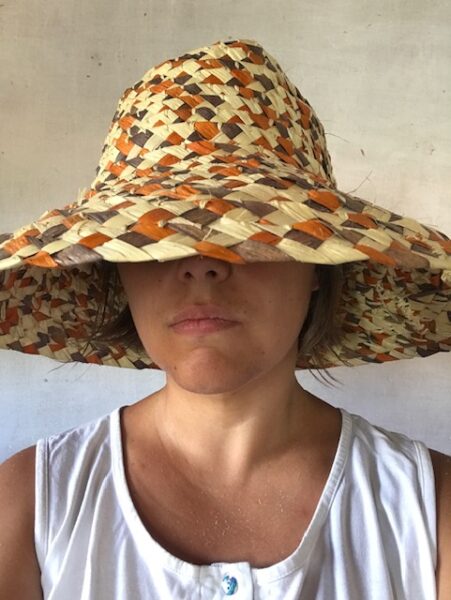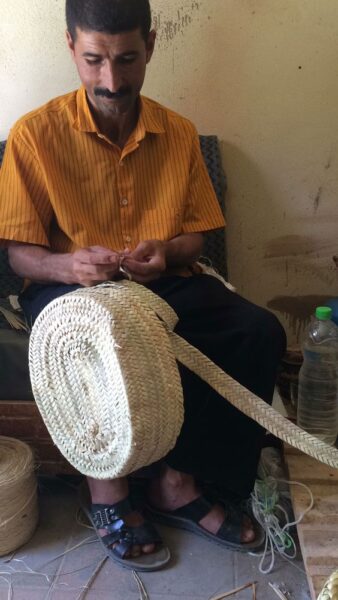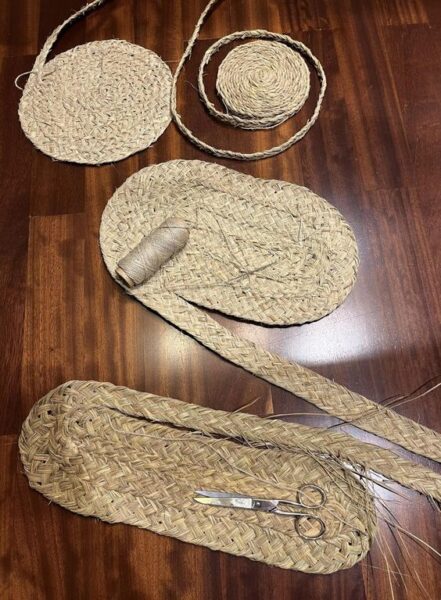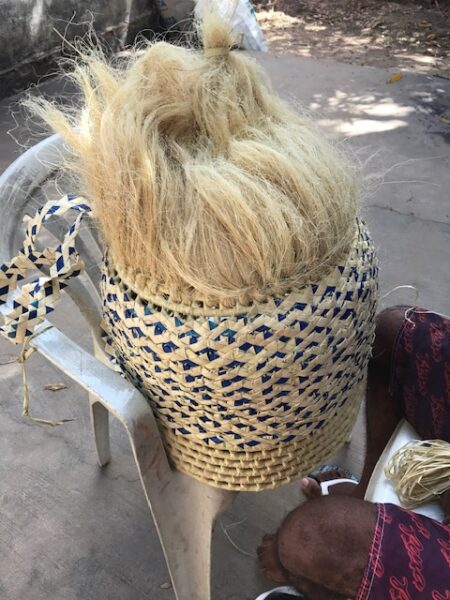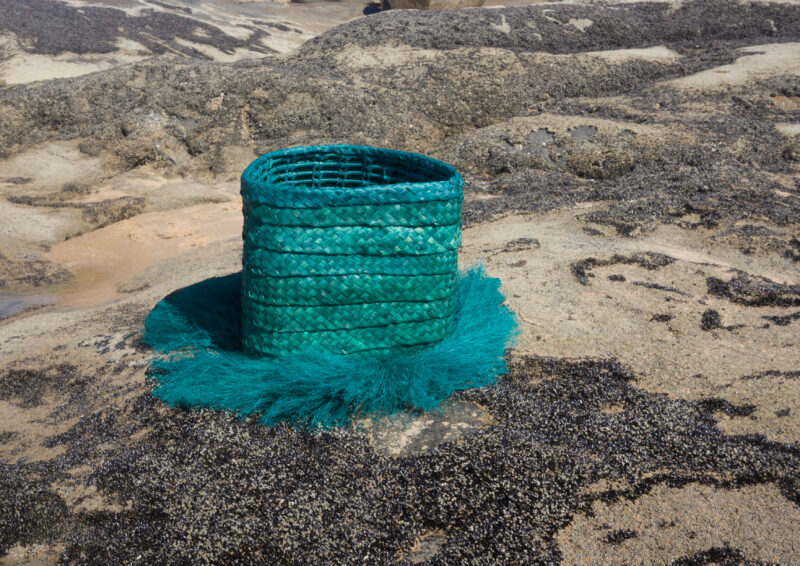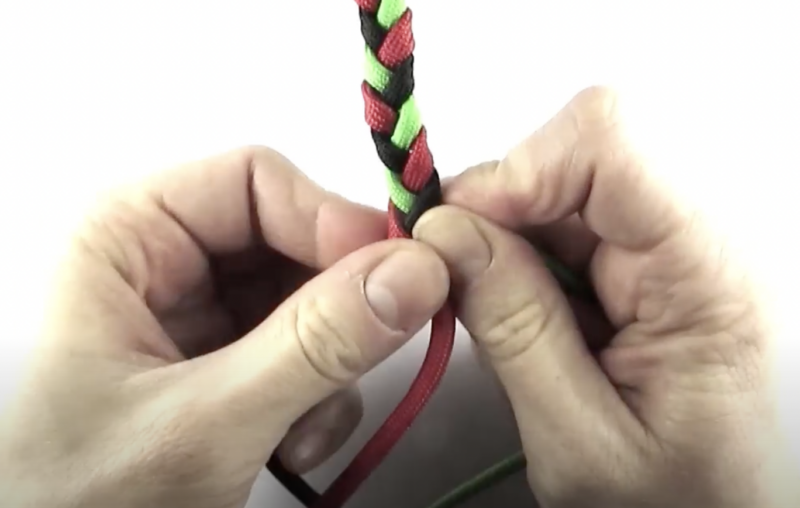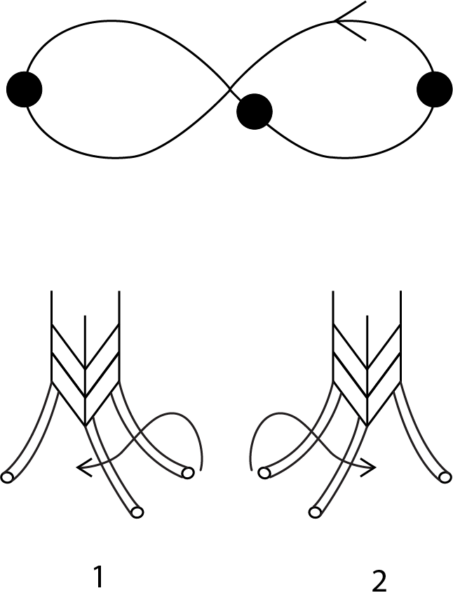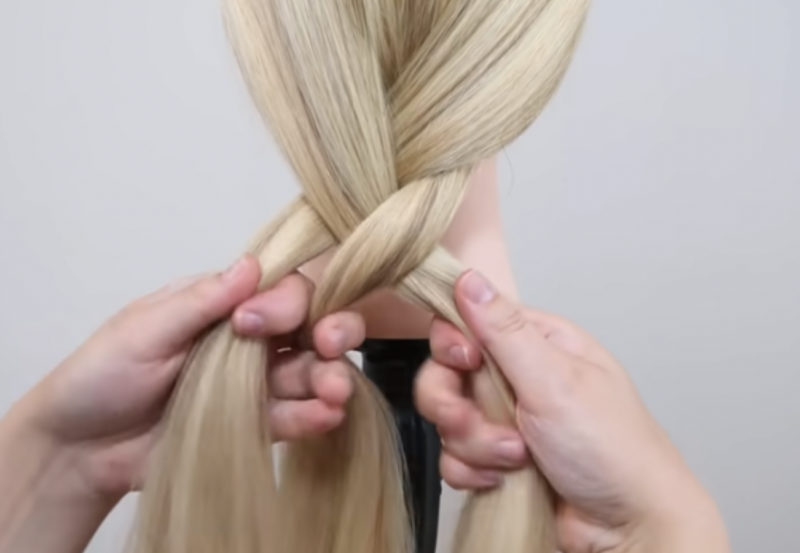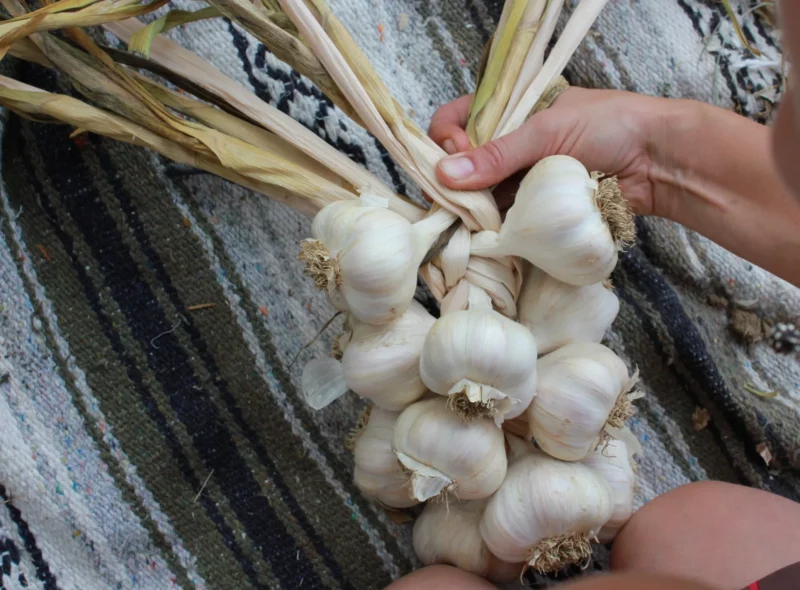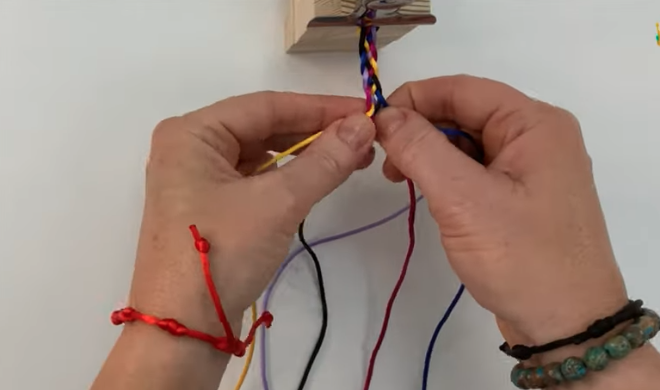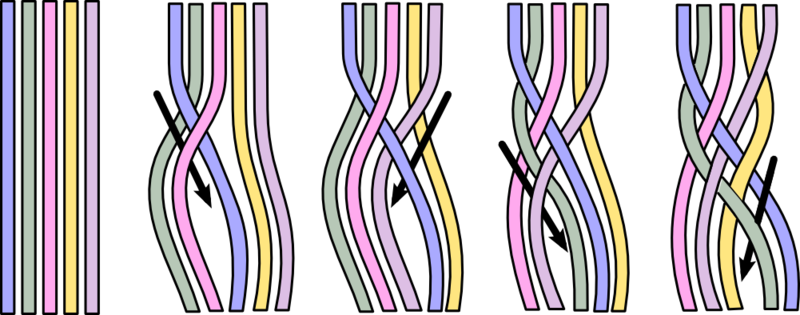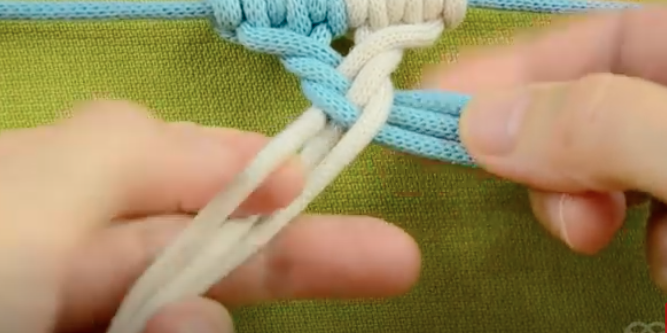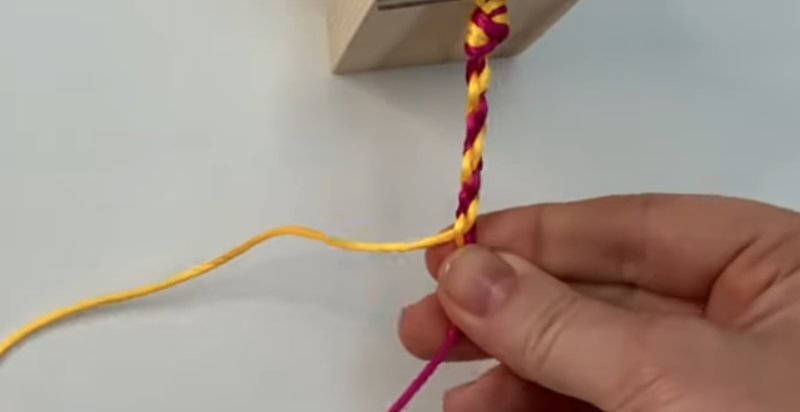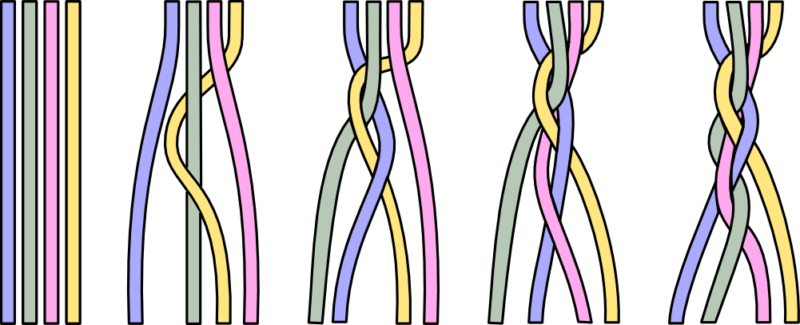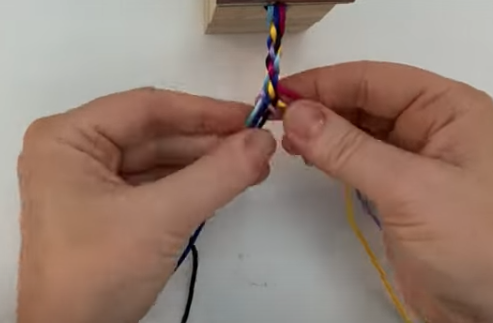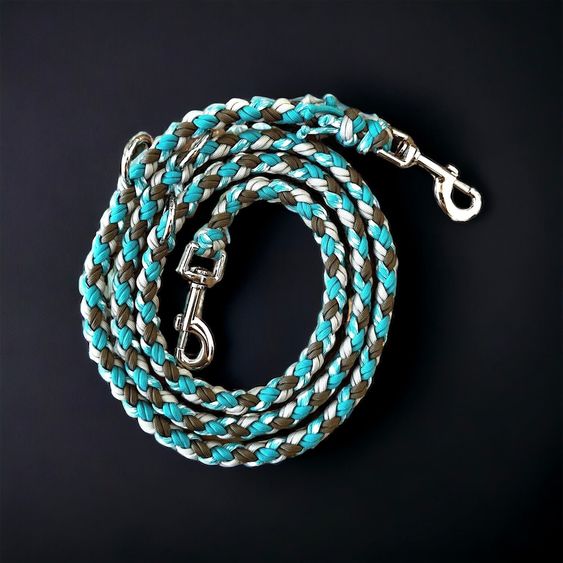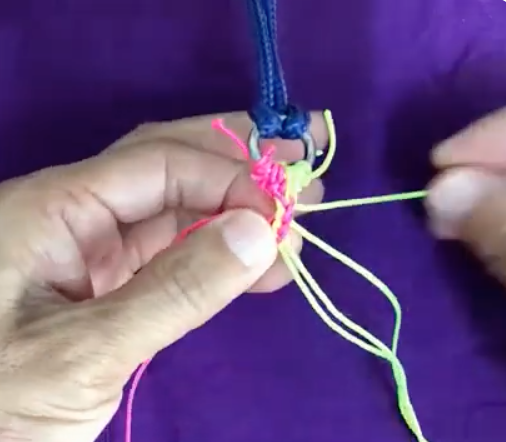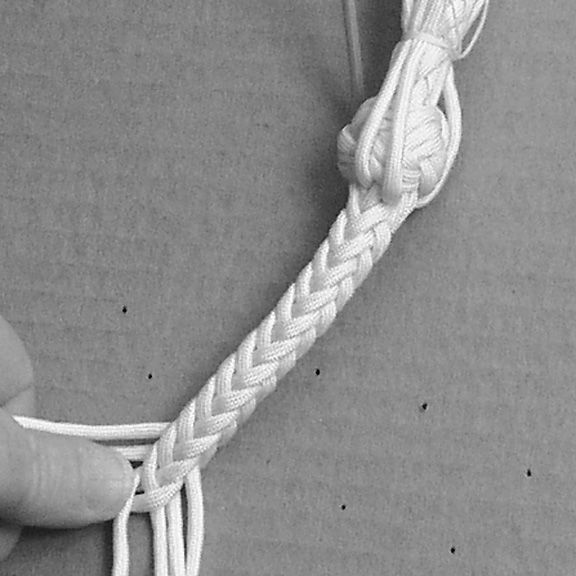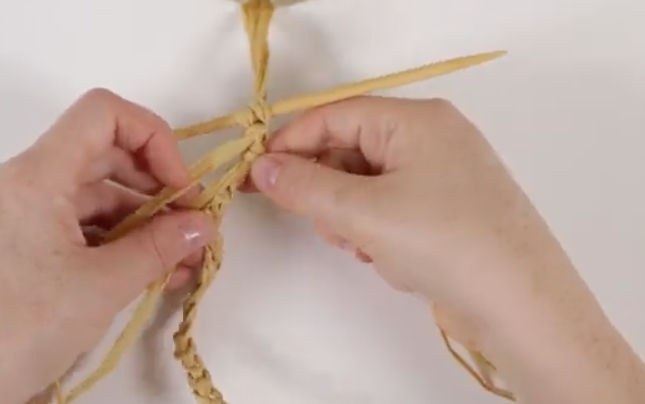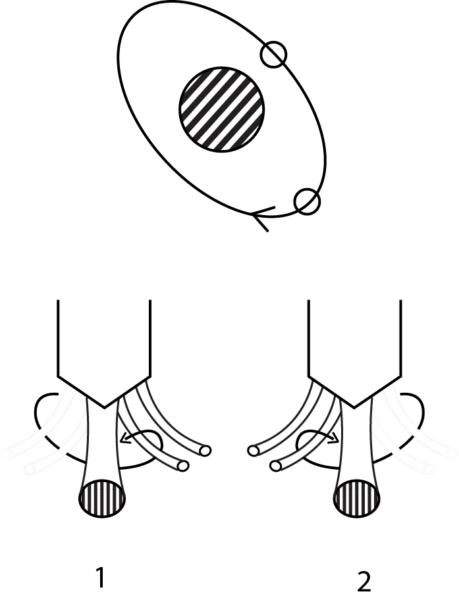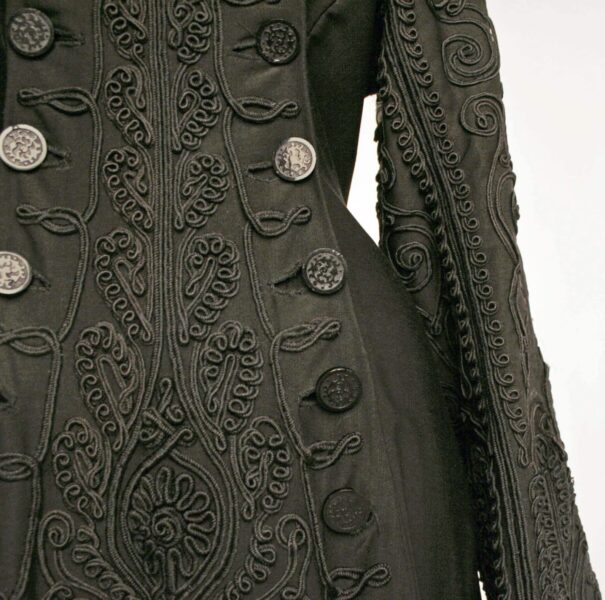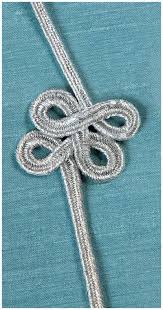Hand braiding free ends
SOFT TOOLS / Crossing
Throughout the history of mankind, hand braiding free ends – which can also be called open or loose ends – has played a crucial role. It was as important as knives or chisels, but – as it was often made from natural materials – most pieces are lost. That’s why it’s complicated to reconstruct its history in detail. Early examples include braiding hair – linked to the Venus of Willendorf from around 30.000 years ago or to hieroglyphs in ancient Egypt, braiding natural materials to carry things or to create slings – as found in the Andes. Until today, traditional challah bread or onions are braided, and you’ll find the technique in rugs, straw hats or clothing. In Africa, braiding hair is still a fundamental part of the culture.
While the technique and patterns were traditionally passed on orally, the British-Swiss textile researcher Noémi Speiser has spent more than ten years to analyse and visualise them. Her system with tracks, which is brought together in The manual of braiding (1988), gives insight into hand braids from different cultures all over the world. A track plan allows to unravel the construction of even the most complex braids. The discovery of this book functioned as a catalysator for our research. The tracks made clear how maypole braiding, hand braiding free ends, fingerloop braiding and even kumihimo on the Maru-dai disk are linked. Although basket plaiting and twining also use loose ends, it’s not possible to translate the movements into a running track.
Unlike Noémi Speiser, Soft Connection Lab uses the tracks as a manual or tool to create. As hand braiding free ends always follows a track, we also call this technique ‘braiding with tracks’. This implicates that all loose ends follow a defined track in a repetitive way. We translated the tracks on different levels: hand-size and human-size, for individuals or groups, and for horizontal or upright positions. Scaling up the tracks to body- and even room-size, enhances the insight into braiding and functions as an eyeopener. Moreover, the scaled-up experience helps to trigger the imagination and innovate the application of the traditional textile braiding techniques.
Roots
Throughout the history of mankind, hand braiding free ends – which can also be called open or loose ends – has played a crucial role. It was as important as knives or chisels, but – as it was often made from natural materials – most pieces are lost. That’s why it’s complicated to reconstruct the history of hand braiding free ends in detail.
The first examples were made to carry things. They were created out of natural materials, making it possible to connect short fibres continuously. Besides the aesthetic appeal of their decorative patterns, the braids also made the fibres stronger by assembling them into one long rope. A remarkable natural material that has a long history of braiding is hair. It is even not clear what was braided first: hair or textiles.
An outstanding archaeological treasure in this context is the Venus of Willendorf, a Palaeolithic figurine, estimated to be around 30.000 years old. Some experts suggest her hair is braided, others presume that it could be basketry or a woven cap. Some of the earliest found evidence of African braiding dates to 3.500 BC. It can be found on the statues and hieroglyphs of ancient Egypt, often portraying figures with complex braided hair.
In South America, the first examples of hand braiding free ends were found in the Andes, dating from around 800 BC-600 AD. Especially the Peruvians and Bolivians were masters in creating the most intricate patterns with natural materials in their slings. During the fifteenth century, Jews in Austria and Southern Germany started to braid their traditional challah bread, influenced by non-Jewish baking practices. In the sixteenth century the early settlers in America started to create braided rugs for their homes, based on Native American weaving techniques. During the Victorian era, artisans used straw braiding to create hats.
Until today, hand braiding free ends is applied also more generally in interior objects and clothing. It was used to create rugs or to finish the edgings of woven textiles after they were taken of the loom. On clothing the braids appear as fringes, edges and general decoration, while even shoes and hats can be braided using free ends. Besides they used to have a practical function: to close clothes. This use might have partly disappeared because of the introduction of new materials like elastics and zippers.
Traditional applications
Hand braiding free ends is constructed by using loose strands that are connected to just one fixed point, to be able to put tension on them. One of the simplest and most common two-dimensional hand braids free ends is the triple hair braid, also called pigtail. The free ends are arranged lengthwise, and result in a braid that is longer than its width or thickness. The free ends always move in the same direction and follow the same sequence. People knew by heart how to construct the braids.
To be able to analyze the traditional applications, the British-Swiss textile researcher Noémi Speiser invented a methodology of tracks. The drawings helped her to follow the movements of the loose ends and to understand how the different braidings were made. It took her twelve years to finish her book The manual of braiding (1988). Studying the book made clear that the movements follow an imaginary track path. If the ends are long enough, the braiding can continue. As the technique also allows to connect shorter ends, the braiding could continue endlessly.
The fascinating art of braiding hair
Each region, community or tribe in Africa had its unique hair braiding style, linked to a specific significance. The hair braids revealed various aspects of the identity of their wearer, including age, religious beliefs, family lineage, societal status and ethnicity.
In the sixteenth century, when African slaves were brought to Colombia, they started to use their hair as a tool to encrypt messages. They even drew maps in their hair to indicate escape routes. It shows how braiding hair functioned – and still functions – as a language. For almost a century, from the Emancipation Proclamation in 1863 to the Black Power Movement of the 1960ies and 1970ies, braids and cornrows were swapped for straightened styles that fit the mould of European beauty standards. The Black Power movement made them popular again, with many black Americans reembracing their natural hairstyles and African heritage.
Another important characteristic of braiding hair is its social power. As it takes quite some time, it’s the perfect moment to socialize. At first, the elderly make simple knots and braids for younger children. Older children watch, learn and start practicing on younger children. Eventually, they learn the traditional patterns. Doing so, this tradition strengthens the bounds between generations.
Even food can be braided
Before baking the dough of the traditional Jewish challah bread is divided in different strands, and then braided. Challah refers to the portion of bread given to the priest as a religious offering. The tradition of braiding challah began in Austria and Southern Germany during the fifteenth century, influenced by non-Jewish baking practices. Braiding not only added an aesthetic touch but also held a symbolic significance, as it represented the Sabbath bride’s hair. The number of braids could signify wealth and status, with wealthier households having more elaborate braids. Over time, challah evolved into a simple bread consumed on the Sabbath and holidays.
Another surprising application of a flat hand braid can be seen until today in onions or garlic. By keeping the stems attached, the garlic bulbs and onions stay longer fresh. At the same time, the braid allows to hang – and thus dry and store – them.
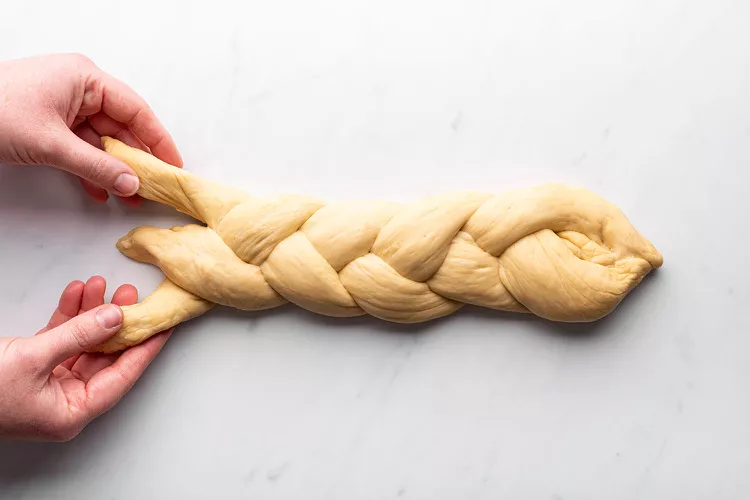
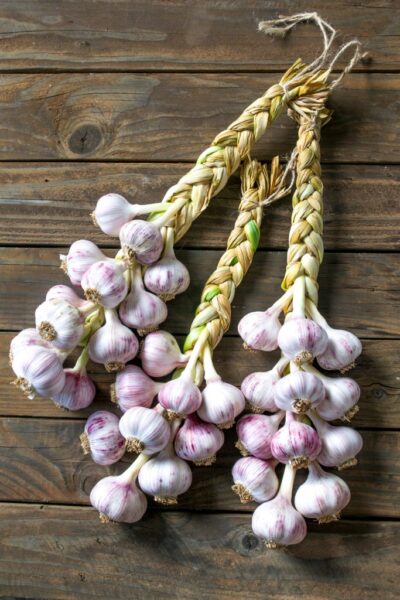
Extraordinary slings from the Andes
The first examples of hand braiding free ends found in the Andes date from around 800 BC – 600 AD. They created round or square braided cords for slings, belts and packaging, and flat braided cords for turbans and belts. They only used natural materials. Fibres were first twisted, and, by braiding, these twisted fibres were transformed into a much stronger cord that could be used in slings. Moreover, the cords were not only stronger but also more beautiful with their different patterns.
Although almost all hunting people in the world used slings, the Peruvians and Bolivians made the most intricate patterns. Some antique Andean slings, as you can see in the pictures, feature complex plaiting with concentric diamond patterns and finely plaited end cords. They were locally known as ‘eye of the water’ and functioned as a powerful ethnic symbol. Sometimes they were found in the medicine bundles of aged lama herders. Today, slings are still used to drive lamas, alpacas or sheep, or for festival costumes.
If you want to learn how to create your own 16 strand Peruvian braid, you’ll find an extensive manual on the website Jeanleader.co.uk.
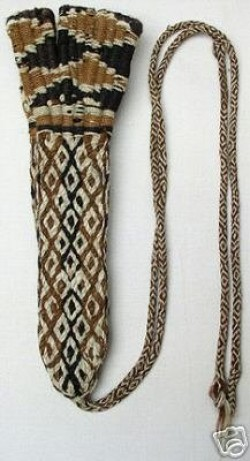
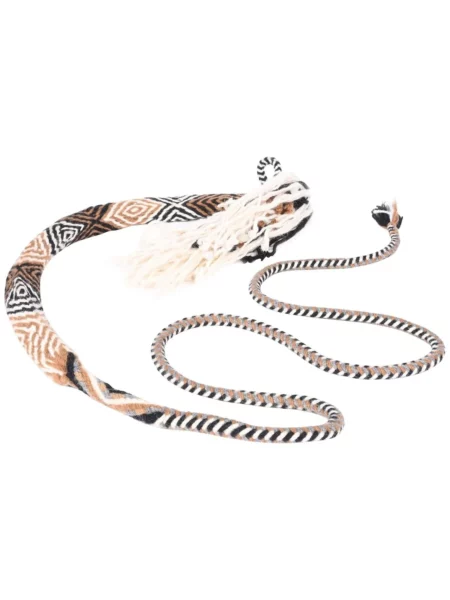
From rag rug to straw hat
Native American weaving techniques were used to make saddle blankets, ponchos, and ceremonial rugs. Inspired by these colourful items, the early settlers in America started to create braided rugs for their homes. These rugs emerged in the colonies from the late 1500s to the early 1600s, and were made from scraps of wool, cotton, and burlap. Women often plaited strips of material together, and then stitched them together to create the rugs.
Nowadays, these rugs are often made with old shirts, sheets and scrap fabric. By cutting the fabric into strips, braiding them in ling ends and stitching them together, colourful rugs can be made.
During the Victorian era, hats were made using a similar technique. They were made from scratch: straw or grass was cut, bleached and then braided. Straw braiding was also called straw plaiting or straw platting. These straw braids were then sewn together to create the real hats.
Watch & learn
Hand braiding free ends can be divided in different structures. It is possible to braid flat, round or square – and thus two- and three-dimensional – shapes, but you can also braid around a core. The free ends follow a sequence of movements that results in a specific shape. Soft Connection Lab summarizes the movements visually in a braiding track, with dots representing the free ends. If you understand how you need to follow the track, you’ll comprehend the basic principle of this technique.
Tracks can be very simple, for example when all the ends just follow one and the same track. When different tracks are combined or when the tracks cross each other multiple times, it becomes more complex. Luckily the tracks are a constant sequence of the same movements that can be followed, and the more you braid, the more it becomes a repetitive action.
No matter how different the tracks are, one basic law is crucial: only one free end moves at a time, while the other ends are waiting. Another characteristic of these braids is that the sequence of the movements always goes to the centre of the braid. The free ends are always attached to a fixed point. This makes it possible to put tension, which is necessary to get a proper braid.
Hand braiding free ends shows similarities to sprang and finger loop braiding. lf both ends of the strands are fixed and we start braiding, the same interlacings occur at both the top and the bottom. This results in a structure closely related to sprang. If we start similar braiding techniques with looped ends instead of free ends, we get a structure that is called ‘fingerloop braiding’ or two-dimensional loop braiding.
Flat braids
In a flat braid we only have one track. This track can cross itself one or multiple times and should hold a minimum of three free ends. In the track of a triple flat braid, the two outer ends always pass over the centre end, from left to right and back.
One of the simplest and most common flat braids is the triple hair braid, also called pigtail. Another surprising application is braiding fresh garlic to dry and for storage. By braiding the stems, the garlic bulbs stay longer fresh.
The videos and drawings show examples of hand braiding with three, five and six free ends.
Round braids
To get a round or tubular braid, a minimum of four free ends is needed. The ends cross each other in a way that gives the braid depth and dimension. To make this braid two tracks need to cross each other. The ends always follow the same track and can never switch to another track.
The four strand tubular braid is also called ‘sinnet’ or’ sennit’. The term sinnet is an equivalent to a braid in the sense of a braid of fibre to make cordage. It is not used as a braid for hair unless you like to make cordage out of the hair…
We share videos and drawings of round braids with four and six free ends.
Square braids
To get a square braid, a minimum of four free ends is needed. The free ends cross over two or more other ends. This gives the braid a square structure with straight ridges. To make this braid, two tracks cross each other. The ends always follow the same track and can never switch to another track.
We share a video and drawings about the soiree braid with eight free ends. It is also called the steamgasket braid.
Braiding around a core
Hand braiding free ends can also be done with a core inside the braid. The same tracks for a flat, round or square braid can be followed. The only difference is that the braiding happens around a fixed core. The braiding can be done around one or multiple cores. Depending on the material used for the core, it can make the braid stronger or more flexible, but it also influences the look and feel. This core can exist of another rope, a bundle of yarns or waste yarns. In Dutch we call the core of the braid ‘the soul’.
A particular example of a braid around a core is the soutache braid. This flat braid is braided around two cores. The V- shape makes it easy to stitch through the center of the braid and sew it as decoration on clothes and costumes. As the braid is narrow and flexible, it can be shaped into round and more sophisticated designs. Soutache braiding goes back to the seventeenth century, as application on military uniforms to denote rank and regiment. Both the epaulettes and cuffs were decorated.
We share videos and drawings about braiding around one core and about braiding around two cores, which is better known as soutache braiding.
